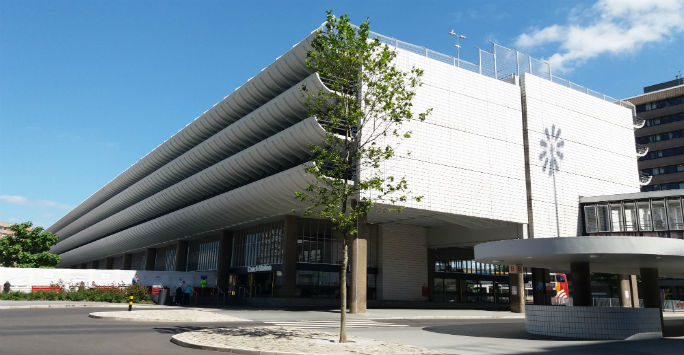So what’s behind this relatively new trend of including existing buildings in awards originally conceived to celebrate new designs?
“It largely reflects the increasing significance of re-using existing building stock for environmental purposes, along with other concerns about the built environment. Research within the Liverpool School of Architecture has played a key role in challenging misconceptions about brutalism and in bringing about considerable changes to public, professional and stakeholder understanding and appreciation of brutalist buildings.”
Dr Christina Malathouni, based in the Liverpool School of Architecture.
Saving an iconic building
Dr Malathouni researched and wrote the successful listing application for Preston Bus Station, submitted to English Heritage (now Historic England) on behalf of the Twentieth Century Society in December 2012.
The building re-opened last year to great fanfare - and this October celebrates its fiftieth birthday - but the bus station’s future didn’t always seem so rosy. The listing saved the building from demolition and concluded a fifteen-year campaign for its protection, after two previous failed listing attempts in 2001 and 2010. It has become a landmark case in post-war architectural heritage, as recognised by the 2014 Heritage Alliance Heroes Award, the only time to date that a post-war building has received this award.

By means of original archival and context research, Dr Malathouni’s listing application established the pioneering use of Glass Reinforced Polyester (GRP) in the design and construction of Preston Bus Station, in conjunction with concrete.
“GRP had played a key role in the realisation of key elements of the bus station, including its distinctive curvilinear slab ends and signage constructions, which demonstrated the innovative interdisciplinary design approach of its designers. As this information had been overlooked in earlier heritage evaluations of the building, it was possible to re-open the listing within less than two years, despite the norm being that at least five years must pass between successive evaluations,” says Dr Malathouni.
Wider impact
The wider significance of the case is reflected in its inclusion in an international ICOMOS conference in Chandigarh, India, in October 2013, and the publication of an account of the listing saga in a reputable, peer-reviewed architectural history journal that normally focuses on research in the Asia-Pacific region.
After the successful Grade II listing was granted, RIBA ran an international architectural competition to have the building refurbished, won by John Puttick Associates. The result has been enthusiastically received by its new owners, Lancashire County Council, upon its opening in July 2018.
In May 2019, Lancashire County Council were awarded the RIBA North West Client Award and the building won three more RIBA Awards: an RIBA North West Award, the RIBA North West Conservation Award, and an RIBA National Award which placed the refurbished building in the Stirling Prize longlist. The Architects’ Journal has also placed the building in its shortlist for the AJ Retrofit Awards 2019: Cultural and Listed Buildings.
Championing brutalism
The Liverpool School of Architecture has a long and distinguished reputation of placing architectural history at the core of the practice of architecture and a strong record of engagement with wider audiences and heritage groups. The School also has an unusually large body of historians and researchers involved in heritage, several of whom are active in both areas.
A principal research strand for both these groups is British and international post-war architecture. It is in this area that, beyond Preston Bus Station, the department has made a substantial contribution to brutalist architecture - one of the most challenging styles of the post-war period.
Dr Barnabas Calder’s research has focused on brutalist architecture for many years. He is an expert on one of the most important post-war architects, Sir Denys Lasdun, whose numerous distinguished brutalist buildings include the National Theatre, the Royal College of Physicians, and the Institute of Education. Dr Calder is author of Raw Concrete: The Beauty of Brutalism (2016) whose broad reach beyond academic and specialist circles has been acknowledged by reviews in a number of non-academic outlets.
Dr Calder says: “Brutalism is an architectural style of the 1960s-70s that has long been misunderstood, hated, and threatened with demolition - a plight paralleled to the threat of extinction that Victorian architecture had faced in the 1950s-60s. It largely comprises large concrete buildings that have often been dismissed as ‘ugly’, ‘crude’, ‘cheap’ and ‘inhuman’.”
Celebrating a milestone
To mark Preston Bus Station’s fiftieth birthday this autumn and examine the current status of brutalist architecture, the School of Architecture, in partnership with the Twentieth Century Society, ran #Brutalismnow. This one-day cross-sector conference, had an impressive line-up from the architecture and heritage sectors.
Back to: Research